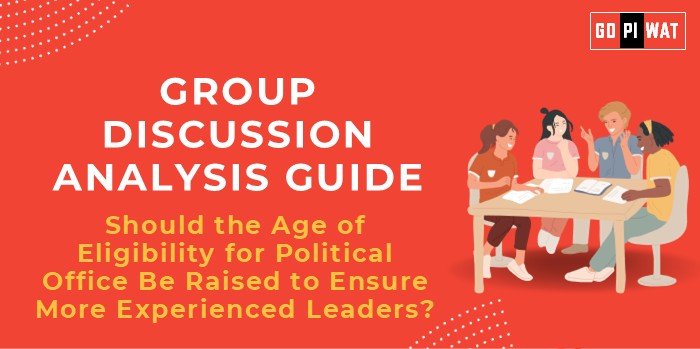📋 Group Discussion (GD) Analysis Guide
🌐 Should the Age of Eligibility for Political Office Be Raised to Ensure More Experienced Leaders?
🌟 Introduction to the Topic
- ⚖️ Opening Context: Political leadership demands a balance of energy, vision, and wisdom. Younger leaders bring fresh perspectives, while experienced leaders are seen as more pragmatic and equipped for complex decision-making.
- 📜 Background: The debate about raising the age of eligibility reflects concerns over effective governance and the need for seasoned policymakers in today’s complex global political environment.
📊 Quick Facts and Key Statistics
- 🌍 Global Practices: Most countries set eligibility for national leadership roles at 35 years (e.g., USA, 35 for presidency).
- 🇮🇳 Indian Context: The minimum age for parliamentary positions is 25 years for Lok Sabha and 30 for Rajya Sabha.
- 📈 Median Age in India: India’s population median age is ~28 years; political representation skews older.
- 👥 Youth Representation: Less than 10% of Indian MPs are under 35 (2024).
- 📑 Policy Impact: Studies show experienced leaders tend to implement long-term development policies more effectively.
🤝 Stakeholders and Their Roles
- 🧑🤝🧑 Citizens: Drive the demand for representation balancing youth energy and experience.
- 🏛️ Government & Legislators: Set eligibility criteria and enact governance standards.
- ⚙️ Political Parties: Field candidates of varied age groups to appeal to diverse voters.
- 🌎 International Examples: Observing global trends in leadership eligibility and effectiveness.
🏆 Achievements and Challenges
✨ Achievements:
- 🌟 Youth Leadership Examples: Elected younger leaders such as Finland’s Sanna Marin demonstrate fresh perspectives.
- 🏅 Experienced Governance: Veteran leaders (e.g., Angela Merkel) have delivered stable policies over long tenures.
⚠️ Challenges:
- 🔄 Policy Continuity: Frequent generational shifts could disrupt policy consistency.
- 📊 Global Comparison: Countries with older leadership (e.g., USA, Japan) struggle with youth-related policies.
💡 Structured Arguments for Discussion
- ✔️ Supporting Stance: “Raising the age will ensure leaders with greater experience, reducing risks of impulsive decision-making.”
- ✖️ Opposing Stance: “Youthful leaders resonate with younger populations, fostering innovation and contemporary governance.”
- ⚖️ Balanced Perspective: “While experience is invaluable, creating a mentorship culture within governance structures could integrate youthful energy and seasoned wisdom.”
🗣️ Effective Discussion Approaches
- 🎯 Opening Approaches:
- 🔎 “Globally, debates on leadership age thresholds often balance experience with dynamism. Where does India stand?”
- 📊 “With the median age of India at 28, should leadership remain predominantly older?”
- 💬 Counter-Argument Handling: Acknowledge experience’s value but advocate for inclusivity through structured mentorship roles for younger leaders.
🔍 Strategic Analysis of Strengths and Weaknesses
- 💪 Strengths: Experienced leaders’ crisis-handling capabilities and historical precedence of impactful senior leadership.
- ⚡ Weaknesses: Risk of generational disconnect with younger populations.
- 🌟 Opportunities: Age reforms could balance representation and efficiency.
- ⚠️ Threats: Potential voter dissatisfaction among younger demographics.
📚 Connecting with B-School Applications
- 📖 Real-World Applications: Relevant for public policy, human resources management, and organizational behavior discussions.
- 🎓 Sample Interview Questions:
- ❓ “How does leadership experience affect governance outcomes?”
- ❓ “Should political age thresholds evolve with population demographics?”
- 💡 Insights for Students: Leadership theory, generational dynamics, and policy impact studies are valuable for internships and thesis work.


